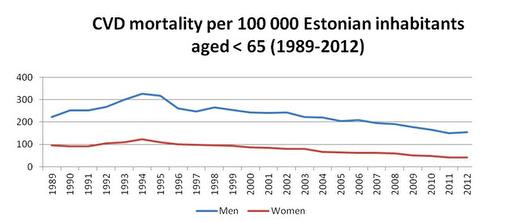Report prepared by Prof Margus Viigimaa with the assistance and advise from:
-
MD PhD Aet Lukmann, Working Group for Cardiovascular Prevention of the Estonian Society of Cardiology
-
Ministry of Social Affairs of the Republic of Estonia.
National CVD Prevention Coordinator for Estonia: Margus Viigimaa
Margus Viigimaa
MD, PhD, FESC
Cardiologist, Professor
Head of the Heart Health Centre and Research Chief of Cardiology Centre of North Estonia Medical Centre
Professor of Cardiovascular Medicine, Tallinn University of Technology
email
Health care | Risk factors | Prevention methods | Prevention activities | Cardiac Rehab. | Future
Documents to download
Health care
While Estonia used to have one of the highest rates of cardiovascular mortality in Europe, the situation is improving. Health behaviour and nutrition studies indicate that the risk factors are improving, albeit at a gradual pace.
Estonian health insurance is a social insurance and it relies on the principle of solidarity. Primary health care is provided by general physicians based in private practices. Fundamental part of primary health care is disease prevention, treatment, assistance, coordination and integration of different services. Hospital health care is provided by licensed hospitals acting as public limited companies or foundations. The number of practicing cardiologists is 130 (10 per 100.000 inhabitants). Total number of Percutaneous coronary intervention (PCI) in 2013 was 3099 (2312 per 1 million inhabitants).
Prevention has been a priority on government level. Estonian National Cardiovascular Prevention Strategy 2005-2020 is the component of the National Health Plan 2009–2020. Estonian Health Insurance Fund has created (together with the Estonian Society of Cardiology) and financed the Estonian CVD Prevention Programme (2000-2012).
Risk factors
Although the life expectancy of Estonian men is low compared to the old European countries, it is growing rapidly. Most important achievement reflecting CVD risk factors management in Estonia is “promotion” from very high risk country to high risk country according the European Guidelines on CVD Prevention in Clinical Practice (2012) of the ESC.
Smoking rate among adults in Estonia is still very high despite the proportion of regular smokers among adults has shown decline over the past two decades. Alcohol consumption is also extremely high in Estonia, at 12.0 litres of alcohol per adult in 2011. Obesity rate among adults is 20.2% in males and 17.6% in females.
The rate of deaths from diseases of the circulatory organs in Estonia is higher than the average in the EU and is 3.5 times higher than that of ‘old’ Europe. Although mortality is higher compared to Europe, it declined the most during 2007–2010 in Estonia.
Source: Estonian Ministry of Social Affairs statistics
Prevention methods and main actors
The main actors are general physicians and cardiologists. In addition, paediatricians are inviting parents to bring their children to clinics for screening so that risk factors may be tackled starting from childhood. There is a network of around 20 smoking cessation offices across Estonia. Members of the public can request a consultation to talk to a pulmonologist specialising in smoking cessation.
The European Guidelines on CVD Prevention in Clinical Practice (2012) of the ESC are endorsed by Estonian Society of Cardiology. The pocket versions of ESC guidelines are translated, introduced and spread out over the country including all involved doctors. There is an established quality control system in Estonian auditing efforts in CVD prevention.
Prevention activities
Main and largest CVD prevention activity is “National strategy for prevention of cardiovascular diseases 2005-2020” issued by Ministry of Social Affairs in public health sector. This strategy is implemented trough 5 strategic areas to the main CVD risk factors physical activity, nutrition, smoking, health care, dissemination of information and securing local capacity. This strategy acts as a part of the Estonia's National Health Plan 2009-2020. Overall objectives are long life and quality of life. By 2020 the average age to which men are living in good health in Estonia will be 60 and for women 65, while the average life expectancy will have risen to 75 for men and 84 for women.
Since 1993 third week of the April is official Heart Week, it is national cluster of CVD prevention and CVD screening activities. Every year there is special focusing slogan to manage CVD risk factors, promote healthy living.
Cardiac rehabilitation
Cardiac rehabilitation activities in Estonia are professionally supervised measures to help patients post myocardial infarction, heart surgery and percutaneous coronary intervention (PCI) procedures such as stenting and angioplasty. These services are partially paid by Estonian Health Insurance Fund but unfortunately high proportion has to be paid by the patients.
The availability of rehabilitation and follow-up treatment has decreased in recent years. Therefore we cannot be satisfied with the present cardiac rehabilitation system in Estonia, especially as acute treatment of myocardial infarction is well organised. We have to make rehabilitation accessible for more patients after acute coronary syndromes and cardiac surgery.
Aims for the future
For the future, ambition plan on national level is to extend the health-adjusted life expectancy and average life expectancy for women and men approximately 3 years by 2020. CVD risk factors managing are very important to achieve this goal. To find financial balance between prevention, treatment and rehabilitation is important as well. We are continuing to carry out activities described in the National Health Plan 2009–2020 and National Strategy for Prevention of Cardiovascular Diseases 2005–2020.
More evaluation of implementation should be carried out to see whether adherence to the European Guidelines on CVD Prevention in Clinical Practice (2012) of the ESC really gives results.
The content of this article reflects the personal opinion of the author/s and is not necessarily the official position of the European Society of Cardiology

 Our mission: To reduce the burden of cardiovascular disease.
Our mission: To reduce the burden of cardiovascular disease.